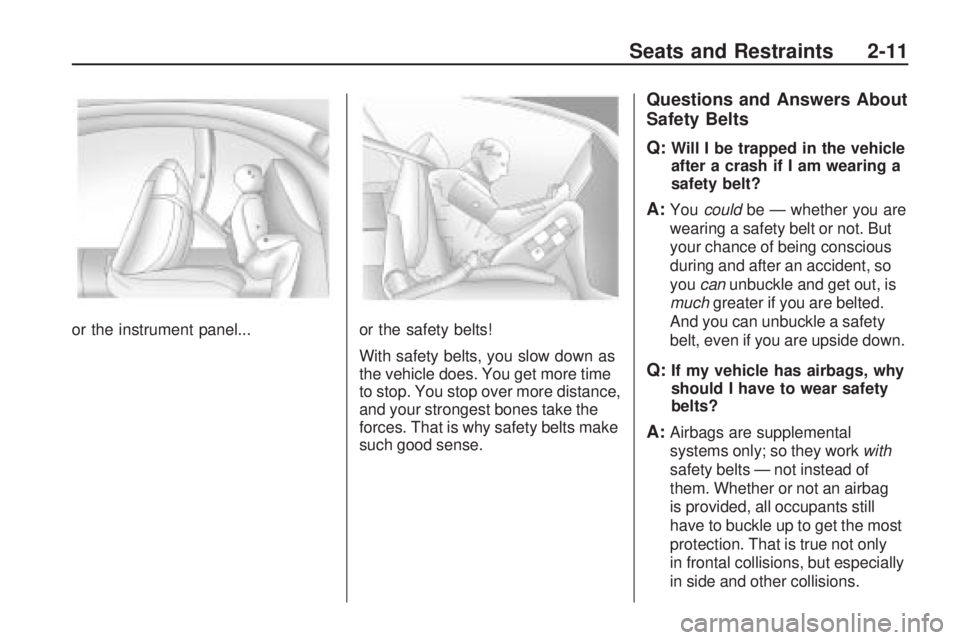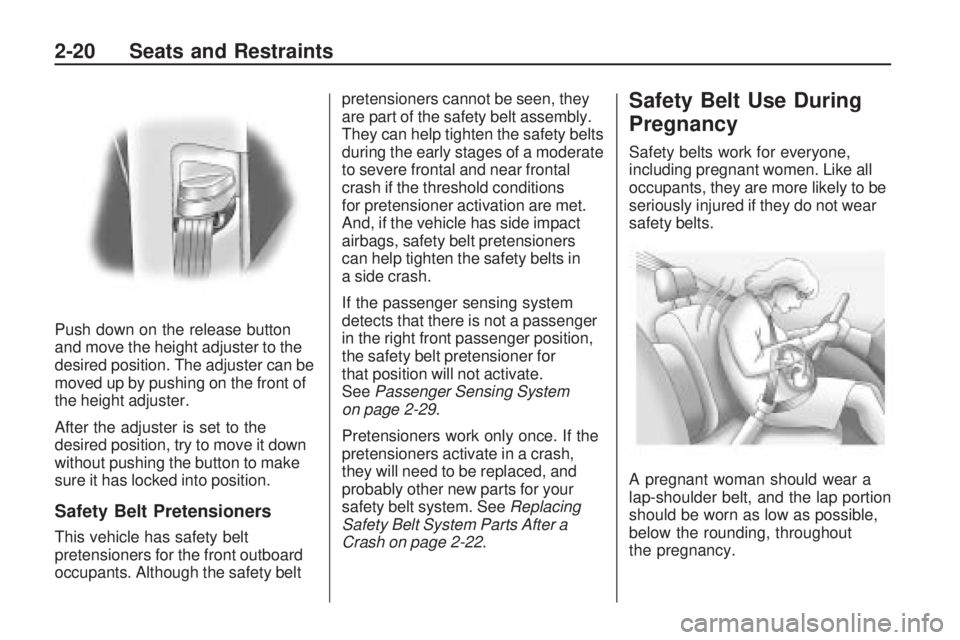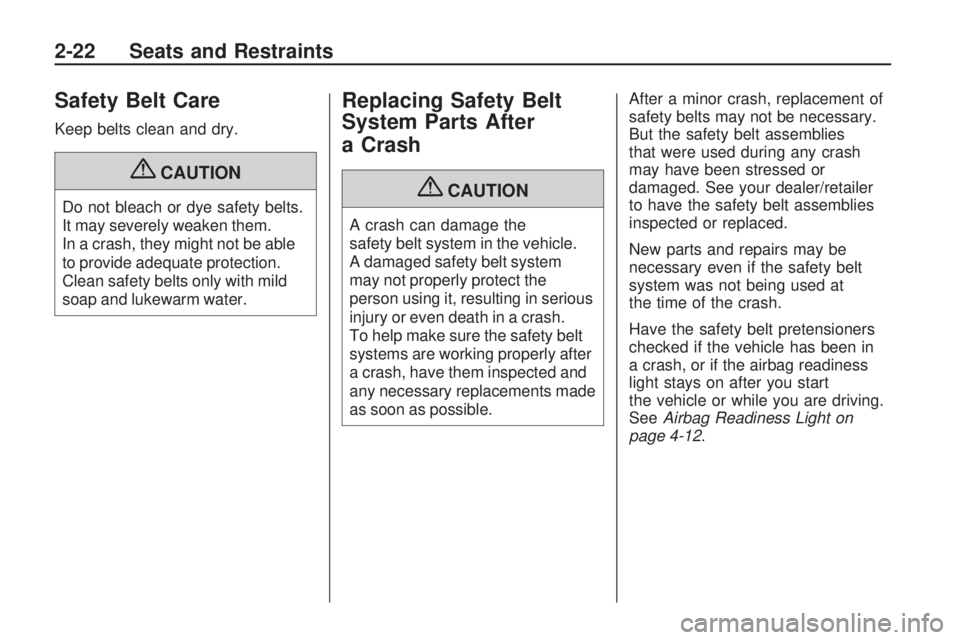2010 PONTIAC VIBE airbag
[x] Cancel search: airbagPage 1 of 318

Keys, Doors and
Windows............................ 1-1
Keys and Locks .............. 1-2
Doors ............................ 1-6
Vehicle Security .............. 1-7
Exterior Mirrors .............1-10
Interior Mirrors ..............1-11
Windows ...................... 1-11
Roof ............................ 1-13
Seats and Restraints......... 2-1
Head Restraints .............. 2-2
Front Seats .................... 2-3
Rear Seats .................... 2-7
Safety Belts ................... 2-8
Airbag System ..............2-23
Child Restraints .............2-37
Storage.............................. 3-1
Storage Compartments .... 3-1
Additional Storage Features ..................... 3-2
Roof Rack System .......... 3-5
Instruments and
Controls............................. 4-1
Instrument Panel Overview .................... 4-2
Controls ......................... 4-4
Warning Lights, Gages, and Indicators ............. 4-8
Vehicle Personalization . . . 4-21
OnStar System .............4-23
Lighting............................. 5-1
Exterior Lighting .............. 5-1
Interior Lighting ............... 5-4
Lighting Features ............ 5-5
Infotainment System......... 6-1
Introduction .................... 6-1
Radio ............................ 6-4
Audio Players ................. 6-9
Climate Controls............... 7-1
Climate Control Systems ... 7-1
Air Vents ....................... 7-4
Maintenance ................... 7-4
Driving and Operating....... 8-1
Driving Information .......... 8-2
Starting and Operating . . . 8-16
Engine Exhaust .............8-23
Automatic Transmission .............8-24
Manual Transmission .....8-29
Drive Systems ..............8-31
Brakes ......................... 8-32
Ride Control Systems ....8-33
Cruise Control ...............8-36
Fuel ............................ 8-38
Towing ........................ 8-43
Conversions and Add-Ons ................... 8-50
Vehicle Care...................... 9-1
General Information ......... 9-2
Vehicle Checks ............... 9-4
Headlamp Aiming ..........9-32
Bulb Replacement .........9-33
Electrical System ...........9-37
2010 Pontiac Vibe Owner ManualM
Page 5 of 318

Vehicle Symbol Chart
Here are some additional symbols
that may be found on the vehicle
and what they mean. For more
information on the symbol, refer
to the index.
9:Airbag Readiness Light
#:Air Conditioning
!:Antilock Brake System (ABS)
g:Audio Steering Wheel
Controls or OnStar®
$: Brake System Warning Light
":Charging System
I:Cruise Control
B:Engine Coolant Temperature
O:Exterior Lamps
#:Fog Lamps
.:Fuel Gage
+:Fuses
i:Headlamp High/Low-Beam
Changer
j: LATCH System Child Restraints
*:Malfunction Indicator Lamp
::Oil Pressure
}:Power
/:Remote Vehicle Start
>:Safety Belt Reminders
7:Tire Pressure Monitor
F:Traction Control
M:Windshield Washer Fluid
Introduction v
Page 21 of 318

Seats and
Restraints
Head RestraintsHead Restraints...................
.2-2
Active Head Restraints ...........2-3
Front SeatsSeat Position.......................
.2-3
Seat Adjustment ...................
.2-4
Reclining Seatbacks .............
.2-4
Folding Seatback .................
.2-6
Rear SeatsRear Seats..........................
.2-7
Safety BeltsSafety Belts.........................
.2-8
How to Wear Safety Belts Properly ...........................
.2-12
Lap-Shoulder Belt ...............
.2-18
Safety Belt Use During Pregnancy .......................
.2-20
Safety Belt Extender ............2-21Safety System Check
...........2-21
Safety Belt Care .................
.2-22
Replacing Safety Belt System Parts After
a Crash ...........................
.2-22
Airbag SystemAirbag System...................
.2-23
Where Are the Airbags? .......2-24
When Should an Airbag Inflate? ............................
.2-26
What Makes an Airbag Inflate? ............................
.2-27
How Does an Airbag Restrain? .........................
.2-28
What Will You See After an Airbag Inflates? .............2-28
Passenger Sensing System ............................
.2-29
Servicing the Airbag-Equipped Vehicle .....2-34
Adding Equipment to the Airbag-Equipped Vehicle .....2-35
Airbag System Check ...........2-36
Replacing Airbag System Parts After a Crash ............2-36
Child RestraintsOlder Children....................
.2-37
Infants and Young Children ...........................
.2-38
Child Restraint Systems ........2-41
Where to Put the Restraint ..........................
.2-43
Lower Anchors and Tethers for Children (LATCH
System) ...........................
.2-45
Replacing LATCH System Parts After a Crash ............2-51
Securing Child Restraints (Rear Seat Position) ...........2-51
Securing Child Restraints (Right Front Seat Position) . . . .2-53
Seats and Restraints 2-1
Page 26 of 318

Folding Seatback
{CAUTION
If you fold the seatback forward to
carry longer objects, such as skis,
be sure any such cargo is not near
an airbag. In a crash, an inflating
airbag might force that object
toward a person. This could
cause severe injury or even death.
Secure objects away from the area
in which an airbag would inflate.
For more information, seeWhere
Are the Airbags? on page 2-24 .
{CAUTION
Things you put on this seatback
can strike and injure people in a
sudden stop or turn, or in a crash.
Remove or secure all items
before driving.
On vehicles with this feature, the
seatback folds down to allow for
more cargo space. When the area
is not being used for more cargo
space or as a temporary table, put
the seatback in the locked, upright
position. Only adjust the seat when
the vehicle is not moving.
To fold the seatback down:
1. Move the seat rearward.
2. Lower the head restraint to the lowest position and make sure
the seatback is at the most
upright position and locked. 3. Pull up on one of the levers
located on either side of the back
of the passenger seatback.
4. Fold the seatback down.
2-6 Seats and Restraints
Page 31 of 318

or the instrument panel...or the safety belts!
With safety belts, you slow down as
the vehicle does. You get more time
to stop. You stop over more distance,
and your strongest bones take the
forces. That is why safety belts make
such good sense.
Questions and Answers About
Safety Belts
Q:
Will I be trapped in the vehicle
after a crash if I am wearing a
safety belt?
A:You could be — whether you are
wearing a safety belt or not. But
your chance of being conscious
during and after an accident, so
you canunbuckle and get out, is
much greater if you are belted.
And you can unbuckle a safety
belt, even if you are upside down.
Q:If my vehicle has airbags, why
should I have to wear safety
belts?
A:Airbags are supplemental
systems only; so they work with
safety belts — not instead of
them. Whether or not an airbag
is provided, all occupants still
have to buckle up to get the most
protection. That is true not only
in frontal collisions, but especially
in side and other collisions.
Seats and Restraints 2-11
Page 40 of 318

Push down on the release button
and move the height adjuster to the
desired position. The adjuster can be
moved up by pushing on the front of
the height adjuster.
After the adjuster is set to the
desired position, try to move it down
without pushing the button to make
sure it has locked into position.
Safety Belt Pretensioners
This vehicle has safety belt
pretensioners for the front outboard
occupants. Although the safety beltpretensioners cannot be seen, they
are part of the safety belt assembly.
They can help tighten the safety belts
during the early stages of a moderate
to severe frontal and near frontal
crash if the threshold conditions
for pretensioner activation are met.
And, if the vehicle has side impact
airbags, safety belt pretensioners
can help tighten the safety belts in
a side crash.
If the passenger sensing system
detects that there is not a passenger
in the right front passenger position,
the safety belt pretensioner for
that position will not activate.
See
Passenger Sensing System
on page 2-29.
Pretensioners work only once. If the
pretensioners activate in a crash,
they will need to be replaced, and
probably other new parts for your
safety belt system. See Replacing
Safety Belt System Parts After a
Crash on page 2-22.
Safety Belt Use During
Pregnancy
Safety belts work for everyone,
including pregnant women. Like all
occupants, they are more likely to be
seriously injured if they do not wear
safety belts.
A pregnant woman should wear a
lap-shoulder belt, and the lap portion
should be worn as low as possible,
below the rounding, throughout
the pregnancy.
2-20 Seats and Restraints
Page 41 of 318

The best way to protect the fetus is
to protect the mother. When a safety
belt is worn properly, it is more likely
that the fetus will not be hurt in a
crash. For pregnant women, as for
anyone, the key to making safety
belts effective is wearing them
properly.
Safety Belt Extender
If the vehicle’s safety belt will fasten
around you, you should use it.
But if a safety belt is not long
enough, your dealer/retailer will
order you an extender. When you go
in to order it, take the heaviest coat
you will wear, so the extender will be
long enough for you. To help avoid
personal injury, do not let someone
else use it, and use it only for the
seat it is made to fit. The extender
has been designed for adults.
Never use it for securing child seats.
To wear it, just attach it to the regular
safety belt. For more information, see
the instruction sheet that comes with
the extender.When a safety belt extender is
installed in the right front passenger
safety belt, make sure the passenger
airbag status indicator displays
ON. See
Passenger Airbag Status
Indicator on page 4-13 .Ifthe
indicator shows OFF, disconnect
the extender’s latch from the buckle
then reconnect the safety belt.
The passenger airbag status
indicator light should be ON
and then the safety belt extender
can be reconnected. If the safety
belt extender is used while the
passenger airbag status indicator
light is OFF, the right front passenger
frontal and seat-mounted side impact
airbags (if equipped) may not
activate correctly.
Always disconnect the extender
from the safety belt after you
use it so that the airbag will work
properly the next time someone
uses that seat.
Safety System Check
Now and then, check that the safety
belt reminder light, safety belts,
buckles, latch plates, retractors and
anchorages are working properly.
Look for any other loose or damaged
safety belt system parts that might
keep a safety belt system from doing
its job. See your dealer/retailer to
have it repaired. Torn or frayed
safety belts may not protect you in
a crash. They can rip apart under
impact forces. If a belt is torn or
frayed, get a new one right away.
Make sure the safety belt reminder
light is working. See Safety Belt
Reminders on page 4-11 for more
information.
Keep safety belts clean and dry.
See Safety Belt Care on page 2-22 .
Seats and Restraints 2-21
Page 42 of 318

Safety Belt Care
Keep belts clean and dry.
{CAUTION
Do not bleach or dye safety belts.
It may severely weaken them.
In a crash, they might not be able
to provide adequate protection.
Clean safety belts only with mild
soap and lukewarm water.
Replacing Safety Belt
System Parts After
a Crash
{CAUTION
A crash can damage the
safety belt system in the vehicle.
A damaged safety belt system
may not properly protect the
person using it, resulting in serious
injury or even death in a crash.
To help make sure the safety belt
systems are working properly after
a crash, have them inspected and
any necessary replacements made
as soon as possible.After a minor crash, replacement of
safety belts may not be necessary.
But the safety belt assemblies
that were used during any crash
may have been stressed or
damaged. See your dealer/retailer
to have the safety belt assemblies
inspected or replaced.
New parts and repairs may be
necessary even if the safety belt
system was not being used at
the time of the crash.
Have the safety belt pretensioners
checked if the vehicle has been in
a crash, or if the airbag readiness
light stays on after you start
the vehicle or while you are driving.
See
Airbag Readiness Light on
page 4-12.
2-22 Seats and Restraints